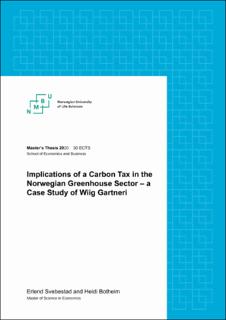| dc.description.abstract | This thesis examines the effects of implementing a carbon tax on the greenhouse sector in Norway, with a specific case study of Wiig Gartneri in Rogaland. The sector is currently exempt from such taxation under the reasoning that carbon dioxide, through photosynthesis, serves as a production input. However, carbon emissions greatly surpass what is required in production, and it is questionable if an exemption can be upheld indefinitely.
Our first research question relates to a scenario where no cost-effective alternative exists, where we look at the elasticity of natural gas demand. By treating the carbon tax as a constant increase in the price of natural gas we find that short term price fluctuations do not affect Wiig Gartneri’s demand.
Our remaining research questions relates to the profitability of three specific technologies we deem promising. These are solar thermal collectors, biogas and woodchip combustion. To examine these technologies, we rely of net present value analysis of energy related expenses over the lifetime of the project and measure the results against a reference scenario.
Our findings show that, despite providing the lowest levelized cost of energy, solar thermal collectors are not a profitable option. This is because of the greenhouse dynamics, where the collectors primarily produce in the summer where carbon dioxide is most scarce.
Further, we find that while not requiring any initial investments, biogas requires a substantial price drop for it to become cost competitive in the foreseeable future.
Finally, despite providing energy at a higher per energy cost than natural gas, the only cost decreasing alternative for the greenhouse is woodchips. This is because the biomass, despite being regarded climate neutral, emits more carbon dioxide than natural gas per energy output. This technology therefore provides a double benefit for the greenhouse, as it decreases expenses regarding both liquid carbon and carbon tax. | en_US |

